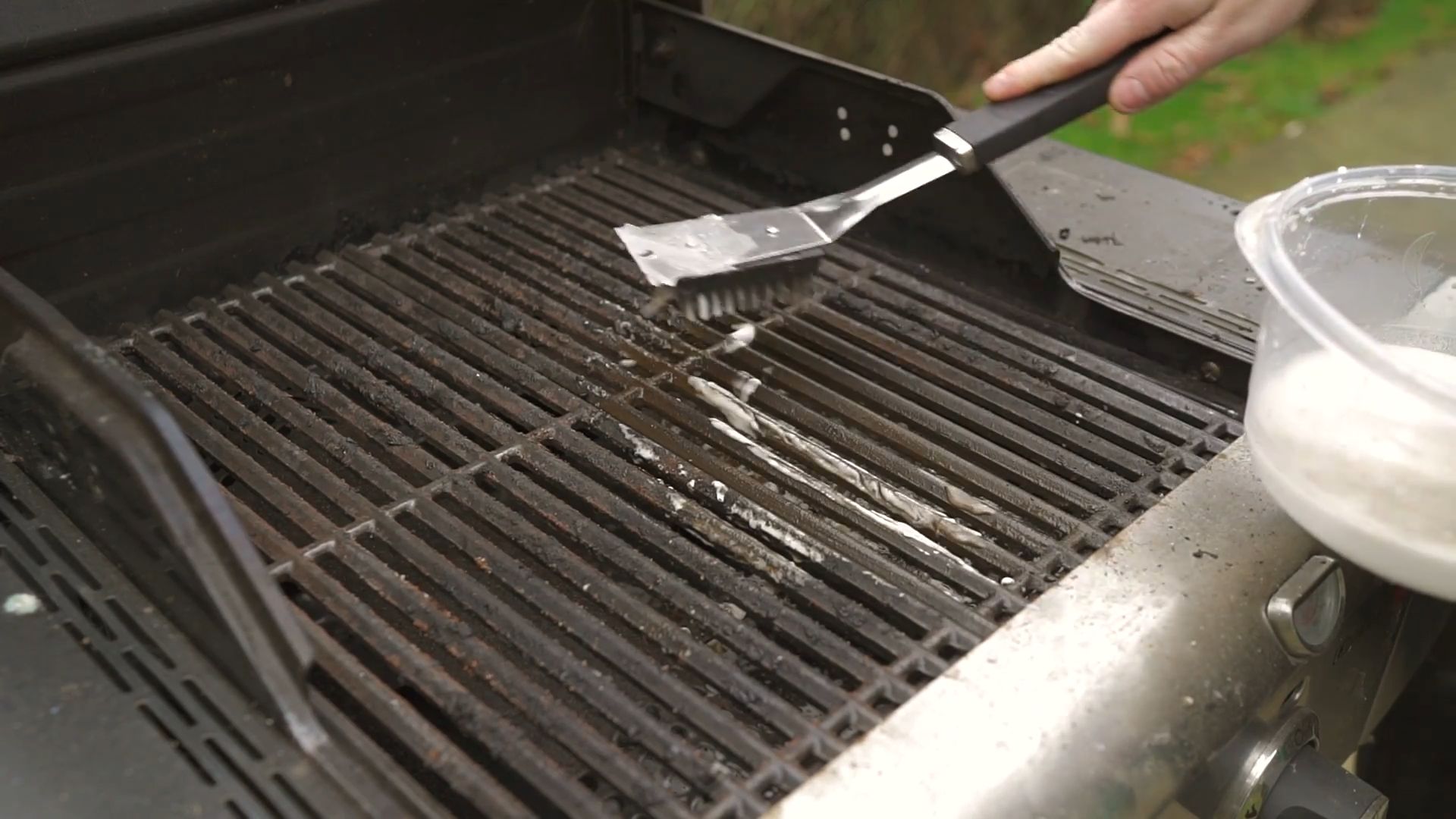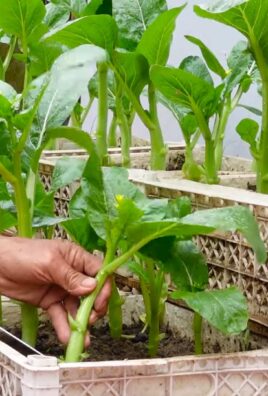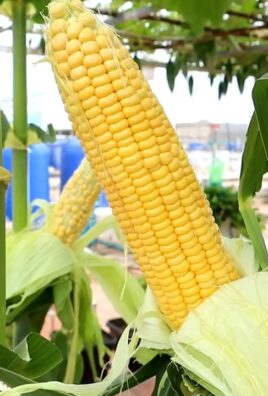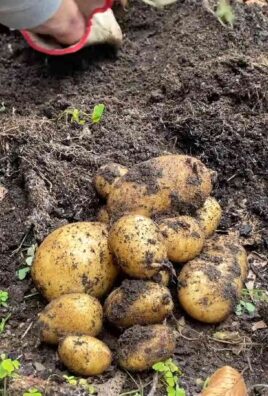Bush beans in pots: Imagine stepping onto your balcony or into your small backyard and harvesting a handful of fresh, crisp bush beans, grown entirely by your own hand. Sounds idyllic, right? Well, it’s more achievable than you might think! For centuries, container gardening has allowed people to cultivate food and beauty even in the most limited spaces. From ancient rooftop gardens in Babylon to modern urban farming initiatives, the desire to connect with nature and grow our own food is deeply ingrained in the human spirit.
But let’s face it, not everyone has acres of land or the time for extensive gardening. That’s where this DIY guide comes in. I’m going to share some simple, yet effective tricks and hacks for successfully growing bush beans in pots. Whether you’re a seasoned gardener or a complete newbie, these tips will help you maximize your yield and enjoy the satisfaction of harvesting your own homegrown goodness. We’ll cover everything from choosing the right pot and soil to providing the perfect amount of sunlight and water. So, ditch the store-bought beans and get ready to embark on a rewarding and delicious gardening adventure!

DIY Abundant Bush Bean Harvest: From Seed to Table in Pots!
Hey there, fellow gardening enthusiasts! I’m so excited to share my tried-and-true method for growing a bumper crop of bush beans right in containers. Forget sprawling gardens; with a little know-how, you can enjoy fresh, homegrown beans even if you only have a balcony or patio. Let’s dive in!
Choosing the Right Bush Bean Variety
First things first, not all beans are created equal! When it comes to container gardening, bush beans are your best friend. They’re compact, productive, and don’t require trellising like their pole bean cousins. Here are a few of my favorite bush bean varieties for pots:
* Blue Lake Bush: A classic for a reason! These beans are reliable, disease-resistant, and produce a heavy yield of delicious, stringless pods.
* Contender: As the name suggests, this variety is a tough cookie. It tolerates cooler temperatures and produces early, making it perfect for shorter growing seasons.
* Provider: Another early producer, Provider beans are known for their exceptional flavor and tender texture.
* Roma II: If you love flat, Italian-style beans, Roma II is the way to go. They’re incredibly productive and have a wonderful, slightly nutty flavor.
* Royal Burgundy: Want to add a pop of color to your garden? Royal Burgundy beans have beautiful purple pods that turn green when cooked. They’re also incredibly tasty!
Gathering Your Supplies
Okay, now that we’ve picked our bean variety, let’s gather everything we need to get started. Here’s a checklist:
* Bush Bean Seeds: Obviously! Make sure you’re buying seeds from a reputable source to ensure good germination rates.
* Large Pots: I recommend using pots that are at least 12 inches in diameter and 12 inches deep. Bush beans need plenty of room for their roots to spread. Fabric pots are also a great option, as they allow for better drainage and aeration.
* High-Quality Potting Mix: Don’t skimp on the potting mix! Use a well-draining mix that’s specifically formulated for containers. Avoid using garden soil, as it can compact and become waterlogged in pots.
* Slow-Release Fertilizer: Bush beans are heavy feeders, so a slow-release fertilizer will provide them with a steady supply of nutrients throughout the growing season. Look for a fertilizer that’s balanced, with equal parts nitrogen, phosphorus, and potassium (e.g., 10-10-10).
* Watering Can or Hose: Essential for keeping your bean plants hydrated.
* Trowel or Small Shovel: For planting the seeds.
* Optional:
* Seed Starting Tray: If you want to get a head start on the growing season, you can start your bean seeds indoors in a seed starting tray.
* Heat Mat: A heat mat can help speed up germination, especially in cooler climates.
* Grow Lights: If you’re starting your seeds indoors, grow lights will provide them with the light they need to thrive.
* Mulch: Mulch helps retain moisture in the soil and suppress weeds. Straw, wood chips, or shredded leaves are all good options.
Planting Your Bush Bean Seeds
Alright, let’s get our hands dirty! Here’s how to plant your bush bean seeds in pots:
1. Prepare Your Pots: Fill your pots with potting mix, leaving about an inch of space at the top. Gently pat down the soil to remove any air pockets.
2. Add Slow-Release Fertilizer: Sprinkle a generous amount of slow-release fertilizer over the surface of the soil. Follow the instructions on the fertilizer package for the correct amount to use.
3. Sow the Seeds: Make small holes about 1 inch deep and 2-3 inches apart. Place 2-3 bean seeds in each hole. Planting multiple seeds per hole increases the chances of at least one seed germinating.
4. Cover the Seeds: Gently cover the seeds with potting mix and water thoroughly.
5. Label Your Pots: Don’t forget to label your pots with the variety of bean you’re growing and the date you planted them. This will help you keep track of your plants.
6. Choose a Sunny Location: Bush beans need at least 6-8 hours of sunlight per day to thrive. Place your pots in a sunny spot where they’ll get plenty of light.
Caring for Your Bush Bean Plants
Now that your bean seeds are planted, it’s time to provide them with the care they need to grow into healthy, productive plants.
1. Watering: Bush beans need consistent moisture, especially during flowering and pod development. Water your plants deeply whenever the top inch of soil feels dry to the touch. Avoid overwatering, as this can lead to root rot.
2. Fertilizing: Even with slow-release fertilizer, your bean plants may need an extra boost of nutrients during the growing season. Side-dress your plants with a balanced liquid fertilizer every 2-3 weeks.
3. Weeding: Keep your pots free of weeds, as they can compete with your bean plants for nutrients and water. Gently pull out any weeds that appear.
4. Pest Control: Keep an eye out for common bean pests, such as aphids, bean beetles, and spider mites. If you spot any pests, treat them with an organic insecticide, such as neem oil or insecticidal soap.
5. Support: While bush beans don’t require trellising, they can sometimes benefit from a little support, especially if they’re loaded with pods. You can use small stakes or tomato cages to help keep the plants upright.
Harvesting Your Bush Beans
The moment we’ve all been waiting for! Harvesting your homegrown bush beans is one of the most rewarding parts of gardening.
1. Timing: Bush beans are typically ready to harvest about 50-60 days after planting. The pods should be firm, plump, and snap easily when bent.
2. Harvesting Technique: Gently snap the bean pods off the plant, being careful not to damage the stems or leaves. Harvest your beans regularly, as this will encourage the plant to produce more pods.
3. Storage: Freshly harvested bush beans are best eaten right away. However, you can store them in the refrigerator for up to a week. To store them, place the beans in a plastic bag or container and keep them in the crisper drawer. You can also freeze bush beans for longer storage. To freeze them, blanch the beans in boiling water for 2-3 minutes, then transfer them to an ice bath to stop the cooking process. Drain the beans and spread them out on a baking sheet to freeze. Once they’re frozen, transfer them to a freezer bag or container.
Troubleshooting Common Problems
Even with the best care, you may encounter some problems while growing bush beans in pots. Here are a few common issues and how to address them:
* Poor Germination: If your bean seeds aren’t germinating, it could be due to several factors, such as cold soil, old seeds, or overwatering. Make sure the soil temperature is at least 60°F (16°C) before planting. Use fresh seeds and avoid overwatering.
* Yellowing Leaves: Yellowing leaves can be a sign of nutrient deficiency, overwatering, or pest infestation. Check the soil moisture and nutrient levels. If necessary, fertilize your plants with a balanced fertilizer. Inspect the leaves for pests and treat them accordingly.
* Lack of Flowers or Pods: If your bean plants are growing well but not producing flowers or pods, it could be due to a lack of sunlight, poor pollination, or excessive nitrogen. Make sure your plants are getting at least 6-8 hours of sunlight per day. You can also try hand-pollinating the flowers by gently shaking the plants. Avoid using fertilizers that are high in nitrogen, as this can promote leafy growth at the expense of flowering and pod production.
* Root Rot: Root rot is a fungal disease that can occur in overwatered soil. Symptoms include yellowing leaves, wilting, and stunted growth. To prevent root rot, make sure your pots have good drainage and avoid overwatering. If you suspect root rot, remove the affected plants from the pots and discard the soil. Replant the plants in fresh potting mix.
Enjoying Your Homegrown Bush Beans
Congratulations! You’ve successfully grown a bountiful harvest of bush beans in pots. Now it’s time to enjoy the fruits (or rather, vegetables) of your labor. Here are a few of my favorite ways to prepare and enjoy homegrown bush beans:
* Steamed or Sautéed: Simply steam or sauté the beans with a little butter, garlic, and salt.
* Bean Salad: Combine cooked bush beans with chopped tomatoes, cucumbers, onions, and a vinaigrette

Conclusion
So, there you have it! Growing bush beans in pots isn’t just a gardening trend; it’s a game-changer for anyone with limited space, a desire for fresh, homegrown produce, or simply a love for the satisfaction of nurturing something from seed to table. We’ve walked you through the process, from selecting the right pot and soil to providing the essential care your bush beans need to thrive. But why is this DIY trick a must-try?
First and foremost, it democratizes gardening. No sprawling backyard? No problem! A sunny balcony, patio, or even a well-lit windowsill can become your personal bean patch. This accessibility makes fresh, organic produce available to a wider range of people, regardless of their living situation.
Secondly, it’s incredibly rewarding. Watching those tiny seeds sprout, develop into lush green plants, and then burst forth with delicious, crisp bush beans is an experience that connects you to the natural world in a profound way. It’s a tangible reminder of the power of nature and your ability to participate in it.
Thirdly, it’s a fantastic learning opportunity. Gardening, even on a small scale, teaches you about plant biology, soil science, and the importance of environmental factors like sunlight and water. It’s a hands-on education that can spark a lifelong passion for horticulture.
But the benefits don’t stop there. Growing your own bush beans allows you to control the quality of your food. You know exactly what’s going into your plants – no harmful pesticides or herbicides, just pure, natural goodness. And let’s not forget the taste! Freshly picked bush beans, still warm from the sun, have a flavor that far surpasses anything you can find in a grocery store.
Ready to take your bush bean growing to the next level? Consider these variations:
* Succession Planting: Plant a new batch of seeds every few weeks to ensure a continuous harvest throughout the growing season.
* Companion Planting: Plant marigolds or nasturtiums near your bush beans to deter pests and attract beneficial insects.
* Vertical Gardening: While bush beans are naturally compact, you can still provide them with a small trellis or support structure to encourage air circulation and prevent overcrowding.
* Different Varieties: Experiment with different varieties of bush beans to find your favorites. Some popular choices include Blue Lake, Contender, and Provider.
* Container Size Experimentation: While we recommended a specific size, try slightly larger or smaller pots to see how it impacts your yield. Just be sure to monitor watering needs accordingly.
We’re confident that you’ll find growing bush beans in pots to be a fulfilling and delicious experience. So, grab your seeds, your potting mix, and your favorite container, and get started today! Don’t forget to document your journey and share your successes (and even your challenges!) with us in the comments below. We’d love to hear about your experiences and learn from your insights. Happy gardening!
Frequently Asked Questions (FAQ)
What is the best type of pot for growing bush beans?
The ideal pot for growing bush beans should be at least 12 inches in diameter and 12 inches deep. This provides ample space for the roots to develop and allows for good drainage. Terracotta pots are a good choice because they are porous and allow the soil to breathe, but plastic pots are also suitable and tend to retain moisture better. Make sure the pot has drainage holes to prevent waterlogging, which can lead to root rot. Avoid using pots that are too small, as this can stunt the growth of your plants and reduce your yield.
What kind of soil should I use for bush beans in pots?
Bush beans thrive in well-draining, nutrient-rich soil. A good potting mix specifically formulated for vegetables is ideal. Avoid using garden soil, as it can be too heavy and compact, hindering root growth. You can also create your own potting mix by combining equal parts of compost, peat moss (or coconut coir), and perlite or vermiculite. Compost provides essential nutrients, peat moss or coconut coir helps retain moisture, and perlite or vermiculite improves drainage. Adding a slow-release fertilizer to the potting mix at planting time can also provide a boost of nutrients throughout the growing season.
How often should I water my bush beans in pots?
Watering frequency depends on several factors, including the weather, the type of pot you’re using, and the stage of growth of your plants. Generally, you should water your bush beans when the top inch of soil feels dry to the touch. Water deeply, until water drains out of the drainage holes. Avoid overwatering, as this can lead to root rot. During hot, dry weather, you may need to water daily. In cooler, wetter weather, you may only need to water every few days. Check the soil moisture regularly and adjust your watering schedule accordingly.
How much sunlight do bush beans need?
Bush beans need at least 6-8 hours of direct sunlight per day to thrive. Choose a location for your pots that receives plenty of sunlight throughout the day. If you live in a particularly hot climate, you may need to provide some afternoon shade to prevent the plants from overheating. If you don’t have a sunny spot, you can supplement with grow lights.
When is the best time to plant bush beans in pots?
Bush beans are warm-season crops and should be planted after the last frost. The soil temperature should be at least 60°F (16°C) for optimal germination. You can start seeds indoors 2-3 weeks before the last frost and transplant them into pots once the weather warms up. Alternatively, you can direct sow seeds directly into the pots.
How do I fertilize bush beans in pots?
Bush beans are relatively light feeders, but they still benefit from regular fertilization. Use a balanced fertilizer (e.g., 10-10-10) or a fertilizer specifically formulated for vegetables. Follow the instructions on the fertilizer package for application rates. You can also use organic fertilizers, such as compost tea or fish emulsion. Fertilize every 2-3 weeks during the growing season. Avoid over-fertilizing, as this can lead to excessive foliage growth and reduced bean production.
What are some common pests and diseases that affect bush beans?
Common pests that affect bush beans include aphids, bean beetles, and spider mites. You can control these pests with insecticidal soap, neem oil, or by handpicking them off the plants. Common diseases that affect bush beans include powdery mildew, rust, and bean mosaic virus. Prevent these diseases by providing good air circulation, avoiding overhead watering, and using disease-resistant varieties. If you notice signs of disease, remove the affected leaves or plants immediately.
How do I harvest bush beans?
Bush beans are typically ready to harvest about 50-60 days after planting. Harvest the beans when they are firm, crisp, and fully developed, but before the seeds inside become too large. Pick the beans regularly to encourage continued production. Use scissors or pruning shears to cut the beans from the plant, being careful not to damage the stems.
Can I grow bush beans indoors?
While it’s possible to grow bush beans indoors, it can be challenging to provide them with the amount of sunlight they need. If you want to try growing them indoors, choose a sunny windowsill or use grow lights to supplement the natural light. Make sure the plants have good air circulation and are not overcrowded.
How many bush bean plants can I grow in one pot?
A good rule of thumb is to plant 3-4 bush bean plants in a 12-inch pot. This allows enough space for each plant to develop without overcrowding. If you’re using a larger pot, you can plant more plants, but be sure to provide adequate spacing between them. Overcrowding can lead to reduced yields and increased susceptibility to pests and diseases.





Leave a Comment